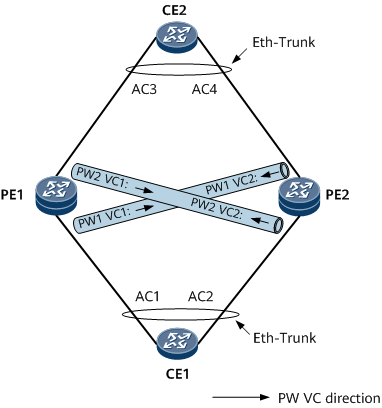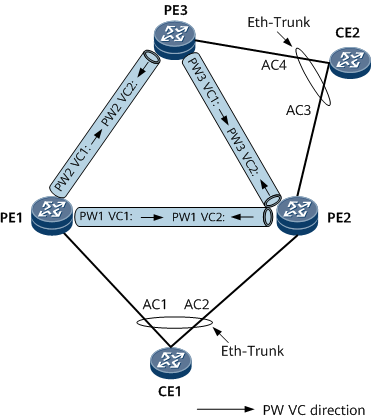Configuring Mutual Protection Between an LDP VC and a CCC VC
This section describes how to configure mutual protection between an LDP VC and a CCC VC. If a CCC VC (or LDP VC) functioning as the primary path fails, traffic is switched to the LDP VC (CCC VC) functioning as the backup path, improving reliability.
Context
The use of Layer 2 virtual private network (L2VPN) technologies increases reliability requirements for L2VPNs. This is especially true of L2VPNs that provide real-time services such as VoIP and Internet Protocol television (IPTV).
To improve L2VPN service reliability, you can configure an LDP VC to protect a CCC VC. If the CCC VC functioning as the primary path fails, traffic can be switched to the LDP VC functioning as the backup path.
Similarly, you can also configure a CCC VC to protect an LDP VC. If the LDP VC functioning as the primary path fails, traffic can be switched to the CCC VC functioning as the backup path.
Mutual protection between an LDP VC and a CCC VC applies to the following scenarios:
Dual-homing 2PE scenario: As shown in Figure 1, CE1 is dual-homed to PE1 and PE2 through an Eth-Trunk, and AC1 is selected as the active AC. CE2 is dual-homed to PE1 and PE2 through another Eth-Trunk, and AC3 is selected as the active AC. PW1 VC1 is deployed between PE1 and PE2 to protect AC3. If AC3 fails, CE1 can access CE2 through PW1 VC1 and AC4. PW2 VC1 is deployed between PE1 and PE2 to protect AC1. If AC1 fails, CE2 can access CE1 through PW2 VC1 and AC2. Therefore, CE1 and CE2 both use AC1 and AC3 for primary links and AC2 and AC4 for backup links. If the primary link fails, service data can be transmitted over the backup link.
Dual-homing 3PE scenario: As shown in Figure 2, CE1 is dual-homed to PE1 and PE2 through an Eth-Trunk. AC1 serves as the primary path, and AC2 the backup path. CE2 is dual-homed to PE2 and PE3 through another Eth-Trunk. AC3 serves as the primary path, and AC4 the backup path. The independent PW redundancy mode is configured on PE1, with PW1 VC1 being the primary PW and PW2 VC1 the secondary PW. The independent PW redundancy mode is also configured on PE3, with PW2 VC2 being the primary PW and PW3 VC1 being the secondary PW. For AC1, there are two paths to CE2: PW1 VC1 (primary) and PW2 VC1 (backup). For AC2, there are two paths to CE2: AC3 (primary) and PW3 VC2 (backup). If the primary path fails, service data can be transmitted over the backup path.
Scenario |
Key Configurations |
|---|---|
Dual-homing 2PE scenario |
LDP VC protecting CCC VC
|
Dual-homing 3PE scenario |
LDP VC protecting CCC VC
|
Pre-configuration Tasks
Configure PW status negotiation. You can configure E-Trunk or VRRP to determine the primary/secondary status of PWs.
Configure static routing or an IGP for the PEs and Ps on the MPLS backbone network to implement IP connectivity.
Configure basic MPLS functions on the PEs and Ps of the MPLS backbone network.
Establish tunnels between PEs based on tunnel policies. If no tunnel policy is configured, LDP tunnels are established by default.
Procedure
- Enable MPLS L2VPN.
- Run the system-view command to enter the system view.
- Run the mpls l2vpn command to enable MPLS L2VPN.
- Run the quit command to return to the system view.
- Create a CCC VC.
- Run the interface interface-type interface-number [ .subinterface-number ] command to enter the AC interface view.
- Run the mpls ccc [ instance-name instance-name ] out-interface interface-type interface-number [ [ ip-interworking | ip-layer2 | raw | tagged ] | [ access-port ] ] * command to create a primary CCC VC.
- (Optional) Run the mpls ccc out-interface interface-type interface-number [ [ ip-interworking | ip-layer2 | raw | tagged ] | [ access-port ] | [ secondary ] ] * command to create a secondary CCC VC.

If you specify the secondary keyword, a secondary CCC VC is created. If this keyword is not specified, the created CCC will be a primary CCC.
- Run the mpls l2vc { ip-address | pw-template template-name } * vc-id [ tunnel-policy policy-name [ endpoint endpoint-address color color-value ] | [ control-word | no-control-word ] | [ raw | tagged | ip-layer2 | ip-interworking ] | access-port | [ secondary | bypass ] | ignore-standby-state ] * command to create a PW.

If you specify the secondary or bypass keyword, a secondary VC is created. If this keyword is not specified, a primary VC is created.
- (Optional) Run the mpls l2vpn pw ignore-ac-state [ secondary | bypass ] command for the PW to ignore the impact of AC status changes on PW service status.
If you want an LDP-based bypass PW to ignore AC status changes, specify the bypass keyword.
If you want an LDP-based secondary PW to ignore AC status changes, also specify the secondary keyword.
In the reliability scenario where an LDP VC is configured to protect a CCC VC, when an AC interface goes Down, the PW status also goes Down. When the AC interface goes Up, the PW has to negotiate the status and reestablish a connection. At this time, if an active/standby PW switchover is being performed, traffic is switched back to the active PW only after the PW negotiation is complete. As a result, the switchback performance deteriorates. To improve the switchback performance, run the mpls l2vpn pw ignore-ac-state command. With this configuration, when an AC interface goes Down, its connected PW remains Up; when the AC interface goes Up, the PW does not have to reestablish a connection.
- Run the commit command to commit the configuration.
Verifying the Configuration
- Run the display mpls l2vpn vpws [ interface interface-type interface-number [ verbose ] ] command to check VPWS-related PW information.

